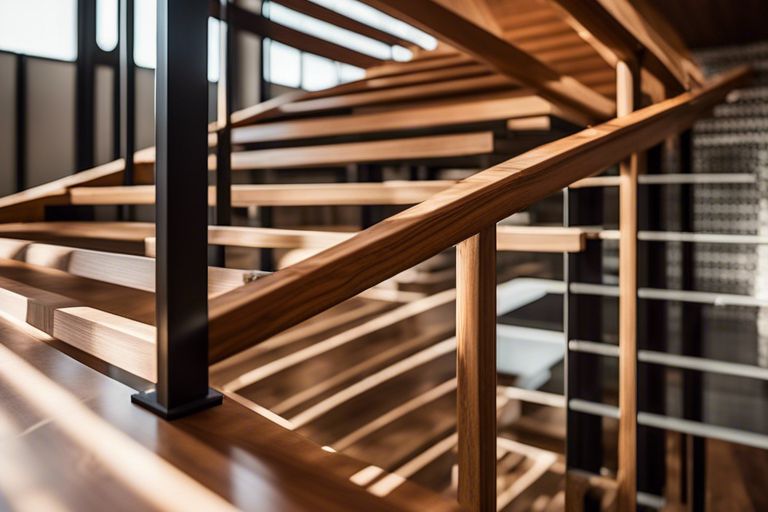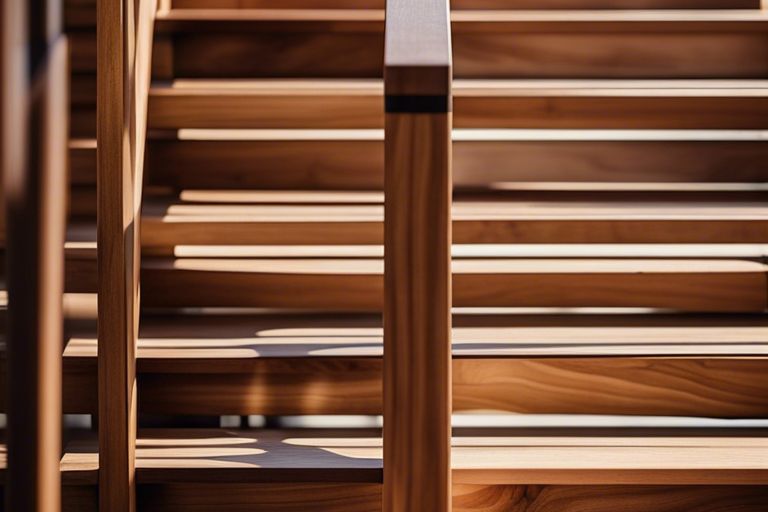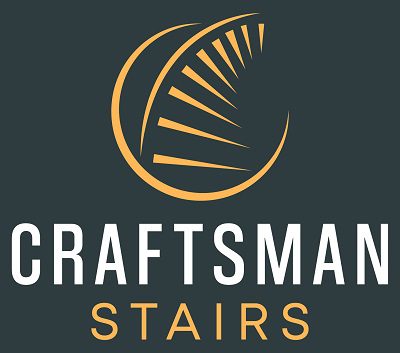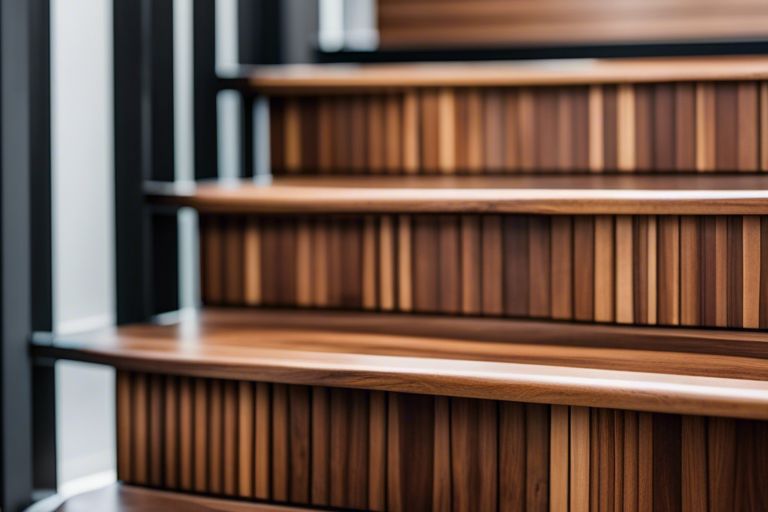Most homes in Australia feature timber staircases, a timeless and classic choice that adds warmth and elegance to any space. Understanding the various timber materials available for staircase construction is crucial for homeowners, architects, and designers looking to create a bespoke staircase design that perfectly suits their needs and style preferences. In this blog post, we will explore the different types of timber staircase materials commonly used in Australia, their unique characteristics, and the factors to consider when selecting the right timber for your staircase project.
Key Takeaways:
- Popular Choices: Common timber staircase materials in Australia include hardwoods such as Jarrah, Blackbutt, and Spotted Gum.
- Durability: Hardwood timber staircase materials are known for their durability and resistance to wear and tear over time.
- Design Options: Timber staircase materials offer a wide range of design options, from traditional to modern styles, catering to various preferences.
- Sustainability: Choosing sustainably sourced timber for staircase materials in Australia helps support environmentally friendly practices and reduces carbon footprint.
- Maintenance: Regular maintenance such as sanding, staining, and sealing is vital to preserve the beauty and longevity of timber staircase materials.
Sure, here’s the requested content for the article “Timber Staircase Materials in Australia”:
Ten Facts About Timber Staircase Materials in Australia
- Timber is a popular choice for staircase materials in Australia due to its natural textures, durability, and beauty.
- The most common timber types used for staircases in Australia are pine and oak.
- Building regulations stipulate that staircases must be at least 600mm wide with a minimum 550mm clearance between handrails.
- Stairs can be between 30-38 degrees steep, and landings are required at least every 36 stairs or with a direction change of 90 degrees.
- Australian standards such as AS 1657, AS/NZ 4586, and AS 1428.1 provide guidelines for stair design, construction, slip resistance, and accessibility.
- Hardwoods like oak and merbau are popular choices for indoor staircases in Australia due to their strength and durability.
- Softwoods like pine are more affordable but less durable options, suitable for interior stairs not exposed to weather or high traffic.
- Thermally modified wood is treated to increase durability and resistance to warping while retaining a natural appearance, offering a sustainable alternative to hardwoods.
- All timber staircases require regular oiling, waxing, or painting to protect them from damage over time.
- Proper protection and maintenance can extend the lifespan of a timber staircase, with hardwood treads lasting 20-30 years with maintenance, while softwood may only last 15 years before needing replacement or refinishing.
Types of Timber for Staircases
If you are considering timber for your staircase in Australia, it’s crucial to understand the various types of timber available. Each type of timber offers unique characteristics and benefits that can impact the overall look and durability of your staircase. To guide you through your decision-making process, we have compiled a list of timber varieties commonly used for staircases. Recognizing the differences between these timber options will help you choose the best one for your staircase project.
Hardwood Varieties
For a staircase that exudes elegance and durability, hardwood varieties are an excellent choice. Hardwoods like Blackbutt, Spotted Gum, and Jarrah are popular choices due to their strength and natural beauty. These timbers are known for their resistance to wear and tear, making them ideal for high-traffic areas like staircases.
Softwood Options
Varieties of softwood, such as Pine and Cedar, offer a more affordable alternative for timber staircases. Softwoods are relatively easier to work with, making them a popular choice for DIY enthusiasts or those on a budget. For instance, Pine is known for its light color and affordability, while Cedar offers a naturally insect-repellent property, making it a practical choice for outdoor staircases.
Properties of Timber Materials
Durability and Strength
To ensure the longevity and sturdiness of your timber staircase in Australia, it is important to consider the durability and strength of the materials used. Australian Cypress, for example, is known for its exceptional durability and strength. This timber species is highly resistant to decay and insect damage, making it an ideal choice for high-traffic areas.
Aesthetic Considerations
One key factor to consider when choosing timber materials for your staircase is the aesthetic appeal. The choice of timber can greatly impact the overall look and feel of your staircase. Australian Cypress, with its unique grain patterns and warm tones, adds a touch of natural beauty to any space.
Materials such as Australian Cypress not only offer durability and strength but also bring a touch of elegance and sophistication to your staircase. The warm tones and distinct grain patterns of this timber species can complement a variety of interior design styles, making it a popular choice among homeowners and designers alike.
Australian Cypress is a fantastic choice for those looking to combine both durability and aesthetic appeal in their timber staircase in Australia.

Sustainable Timber Sourcing in Australia
Certifications and Standards
One of the key factors in ensuring sustainable timber sourcing in Australia is the adherence to certifications and standards set by organizations such as the Forest Stewardship Council (FSC) and the Australian Forestry Standard (AFS). These certifications guarantee that the timber has been harvested in an environmentally and socially responsible manner, promoting the preservation of forests for future generations.
Environmental Impact and Management
Environmental considerations play a crucial role in the sustainable sourcing of timber in Australia. It is vital for timber suppliers to implement effective management practices that minimize the impact on local ecosystems and biodiversity. By conducting thorough environmental assessments and adopting sustainable harvesting techniques, the industry can ensure the long-term health of Australia’s forests.
It is imperative for timber suppliers and consumers alike to prioritize sustainability in the sourcing and usage of timber materials. By choosing certified sustainable timber and supporting responsible forestry practices, we can contribute to the conservation of our precious natural resources and help mitigate the environmental impact of timber production.

Construction and Maintenance
Best Practices for Timber Staircase Construction
Your timber staircase is a significant investment in your home, and ensuring it is constructed properly from the beginning is crucial for its longevity. Construction of timber staircases involves precise measurements, quality materials, and skilled craftsmanship. It is imperative to follow building codes and regulations to guarantee the safety and durability of the staircase. Hiring experienced professionals for the job is highly recommended to avoid potential issues in the future.
Maintenance and Care for Longevity
Longevity
This includes regular cleaning to remove dust and debris that can cause wear and tear on the wood. It’s also important to inspect the staircase for any signs of damage, such as loose steps or railing. Applying a fresh coat of sealant or paint periodically can help protect the wood from moisture and scratches, prolonging the lifespan of your timber staircase. By following a routine maintenance schedule, you can ensure that your staircase remains in top condition for years to come.
Summing up
Upon reflecting on the various timber staircase materials available in Australia, it is evident that each option comes with its own benefits and considerations. From durable hardwoods like Jarrah and Blackbutt to sustainable alternatives like Tasmanian Oak and Pine, there is a material to suit every project and budget. Understanding the properties, maintenance requirements, and aesthetic qualities of each timber is crucial in making an informed decision. Ultimately, the choice of timber staircase material will depend on factors such as style preferences, durability needs, and environmental considerations. By selecting the right material for your staircase, you can enhance the overall appearance and functionality of your space while also supporting the local timber industry.
FAQ
Q: What are the most common materials used for timber staircases in Australia?
A: The most common materials used for timber staircases in Australia include hardwoods such as Victorian Ash, Blackbutt, Spotted Gum, and Jarrah.
Q: Are timber staircases in Australia built to meet specific building codes and standards?
A: Yes, timber staircases in Australia are built to meet specific building codes and standards to ensure they are safe and structurally sound. These codes may vary depending on the state or territory.
Q: What factors should be considered when choosing timber for a staircase in Australia?
A: When choosing timber for a staircase in Australia, factors to consider include durability, hardness, grain pattern, and suitability for staining or painting.
Q: How can I maintain and care for a timber staircase in Australia?
A: To maintain and care for a timber staircase in Australia, regularly clean it with a damp cloth, avoid excessive moisture, and periodically sand and refinish the timber to keep it looking its best.
Q: Can timber staircases in Australia be customized to suit specific designs or requirements?
A: Yes, timber staircases in Australia can be customized to suit specific designs or requirements, whether it’s altering the shape, size, finish, or adding decorative elements to match your preferences.
Q: Are there specific building regulations for timber staircases in Australia?
A: Yes, building regulations stipulate that staircases must be at least 600mm wide with a minimum 550mm clearance between handrails.
Q: How long do hardwood treads typically last with maintenance?
A: Hardwood treads can last 20-30 years with maintenance, while softwood treads may only last 15 years.
Q: What is thermally modified wood, and why is it used for staircases?
A: Thermally modified wood has been treated to increase its durability and resistance to warping while retaining a natural appearance, making it a sustainable alternative to hardwoods.
Q: How often should timber staircases be maintained?
A: Timber staircases should be regularly oiled, waxed, or painted to protect them from damage over time.
Q: Are there specific slope requirements for timber staircases in Australia?
A: Yes, stairs should slope between 30-38 degrees, according to building regulations.
Q: What is the lifespan of a softwood staircase without maintenance?
A: A softwood staircase may last around 15 years without maintenance before needing replacement or refinishing.
Advice & Actionable Tips
- Regularly maintain your timber staircase by oiling, waxing, or painting it to protect it from damage over time.
- Choose hardwood treads for durability and longevity, as they can last 20-30 years with maintenance.
- Consider thermally modified wood as a sustainable alternative to hardwoods, as it is treated to increase durability and resistance to warping.
🌐 Article Sources & Resources
- Australian Building Codes Board: Provides information on building regulations and standards in Australia.
- Australian Standards: Offers access to Australian standards for stair design and construction.
- Craftsman Stairs: Offers insights into Australian design rules and types of stairs in Australia.

